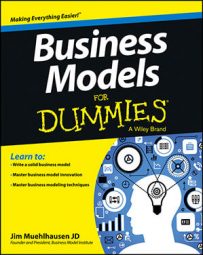There are business models hundreds of years old and those only a handful of years old, such as Internet freemium models. Some of the most profitable companies didn’t invent new business models; they borrowed a business model from another industry.
The Gillette razor and blades model has been highly profitable for Hewlett-Packard’s inkjet printer business and Verizon’s cellphone business. The cheap chic business model works for Trader Joe’s in the grocery business and IKEA in the home furnishing business. Sometimes, one little tweak to an existing business model can yield powerful results in a new industry.
This table shows a partial list of common business models. These examples should get your creative juices flowing as you begin to create your business model. Review the list for small ideas you can work into your model rather than copying a model lock, stock, and barrel.
| Type of Model | Description | Example Companies and Products |
|---|---|---|
| Razor and blades | Consumer purchases a low-margin item like a razor handle or inkjet printer. Sale of necessary consumables such as replacement blades or ink are sold at a very high markup. | Gillette, Hewlett-Packard printers, Kuerig coffee makers |
| Inverted razor and blades | Initial purchase has a high margin, but consumables are sold at a low margin to entice initial purchase or contrast to razor and blade competitor. | Kodak inkjet printers, Apple iPod & iTunes combination. Apple makes very low margins on iTunes but high margins on hardware. |
| Cheap chic | Marketing of stylish but inexpensive merchandise. Typically allows for high margins because merchandise sells at low price points but has an expensive feel. | Target, Trader Joe’s, IKEA |
| Bricks and clicks | Extension of in-store shopping to include online ordering with in-store pickup or items found exclusively online. | BestBuy.com, local mystery book store with online shop |
| Multilevel marketing | Leverage friends, family, and other personal networks to recommend products and act as a sales force. Works best for products needing recommendation to facilitate purchase. | Avon, Mary Kay, Amway |
| Franchise | Sell the right to use the business model in exchange for a percentage of revenues. | McDonald’s, Holiday Inn, NFL |
| Anticipated upsell | High percentage of buyers ultimately purchase more than they expected. For instance, most new home buyers end up spending 1.2 times the base price of the home after extras. Builders bet on this upsell. | Homebuilders, car dealerships, steel fabricators |
| Loss leader | This model offers velocity items for a very low margin in anticipation of additional sales at a higher margin. | Gas stations, $1 menus |
| Subscription model | One of the more popular models because of recurring revenue. Typically involves creating a significant asset and renting a piece of it. | Health clubs, software as a service |
| Collective | Similar to a franchise. Involves many businesses coming together for purchasing, marketing, or operational purposes but with looser ties than a franchise. Typically, collectives aggregate buying power and don’t pay ongoing royalties like a franchise. | Ace Hardware, CarQuest |
| Productization of services | Standardizing a predetermined bundle of services typically bought together and selling for a fixed price similar to a product. Many times it includes an element of flat-fee pricing as well. | A consultant charges $5,000 for a business plan analysis rather than charging $200 per hour, prepaid legal plans |
| Servitization of products | Making a product part of a larger service offering. | Rolls-Royce sells aircraft engines, not as distinct components but as complete solutions based on aviation miles. All operations and maintenance functions are included in this “Power by the Hour” plan. |
| Long tail | Based on Chris Anderson’s famed 2004 Wired magazine article. Selecting a tiny niche and serving it in ways mass marketers can’t. Hopefully, the tiny niche grows into a much larger one, as it did in the case of Fat Tire beer. | YouTube bands, left-handed online store, micro-breweries |
| Direct sales | Bypass the traditional sales channels to target end users. Methods include door-to-door sales and company-owned stores. | Kirby Vacuums, Girl Scout cookies, outlet mall stores |
| Cut out the middle man | Removal of intermediaries in a supply chain. AutoZone bypasses traditional three-step distribution by skipping the warehouse distributor. | Dell Computer, farmer’s markets |
| Freemium business model | Product is offered for free. Typically 8% of users upgrade to become paying customers of virtual goods or to get expanded access. | Angry Birds, shareware software, McAfee security |
| Online auctions | Create a community of buyers and sellers by using an auction-type selling process versus a set sales price. | eBay, Arriba |
| Hotel California model | Create a must-have product that traps customers into buying unrelated high-profit items like concessions at a baseball game. | Amusement parks, sporting events, movie theaters |
| Network effect | Create a product in which the value to each user becomes higher as more people use it. | Fax machines, social networks |
| Crowdsourcing | Leveraging users to co-create products and sell to other users. | Cafepress.com, Frito Lay new flavors, YouTube, Angie’s List |
| Users as experts | Gives users access to technology and tools typically reserved for company employees. Users then create their own designs or versions of the product. | Cook-your-own-steak restaurants, Lego |
| Premium | Offer high-end products that appeal to brand-conscious consumers. | Tiffany, Rolls-Royce |
| Nickel and dime | Price the most cost-sensitive item as low as possible and then charge for every little extra. | Airlines |
| Flat fee | The opposite of nickel and dime. Most or all incidental purchases are bundled into one fee. | Sandals Resorts, Southwest Airlines |

